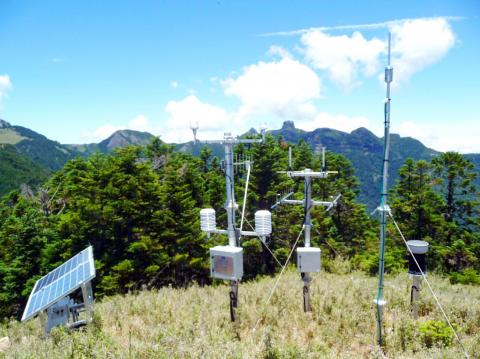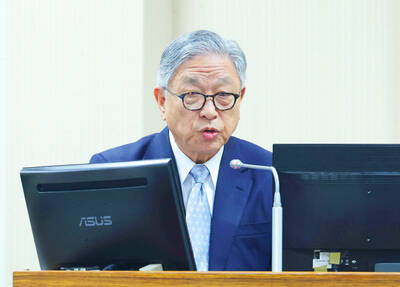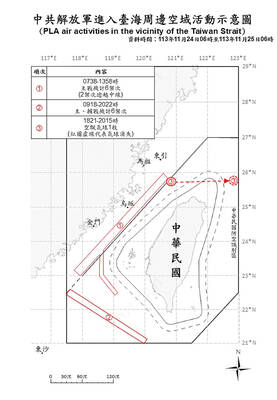Technicians from several government agencies and national park rangers have established four automated meteorological stations at four sites above 3,000m on Yushan (玉山), Hsuehshan (雪山) and Taoshan (桃山), the Central Weather Bureau said on Wednesday.
Surveying the sites and installing equipment for the stations — one in Yushan’s Fongkuo (風口), two in Hsuehshan’s Cyuangu (圈谷) and East Peak (東峰) and one on Taoshan — was a feat of endurance and skill that required personnel to hike several hours on foot in difficult conditions, the bureau said.
The bureau said it collaborated with the Yushan National Park Administration, the Shei-Pa National Park Administration and the Ministry of the Interior’s Construction and Planning Agency to establish the stations so that it could provide people visiting the regions with up-to-date and accurate meteorological data to better protect their safety.

Photo courtesy of the Central Weather Bureau
Before the most recent installations, there were 499 automated stations in Taiwan, the bureau said, adding that the installation of high-altitude stations is rare because of the environmental challenges.
Automated stations at altitudes above 1,500m comprised 8 percent of the nation’s total, while stations above 3,000m made up a mere 1 percent of all stations, the bureau added.
The meteorological data gathered by the stations are to be displayed under “Recreation - Mountain Climbing” on the bureau’s Web site (www.cwb.gov.tw/eng), on weather monitors at Yushan’s Paiyun Lodge (排雲山莊) and on additional monitors to be installed at Hueshan’s entry service point, the bureau said.
Preparation for establishing the stations began early last year, and included site surveys and wireless communication feasibility studies, the bureau said, adding that the installation team expressed its gratitude to the government and civilian experts who assisted with the project.
Volunteers and park rangers will maintain the stations’ equipment, it added.

A decision to describe a Chinese Ministry of Foreign Affairs statement on Singapore’s Taiwan policy as “erroneous” was made because the city-state has its own “one China policy” and has not followed Beijing’s “one China principle,” Deputy Minister of Foreign Affairs Tien Chung-kwang (田中光) said yesterday. It has been a longstanding practice for the People’s Republic of China (PRC) to speak on other countries’ behalf concerning Taiwan, Tien said. The latest example was a statement issued by the PRC after a meeting between Singaporean Prime Minister Lawrence Wong (黃循財) and Chinese President Xi Jinping (習近平) on the sidelines of the APEC summit

Taiwan’s passport ranked 34th in the world, with access to 141 visa-free destinations, according to the latest update to the Henley Passport Index released today. The index put together by Henley & Partners ranks 199 passports globally based on the number of destinations holders can access without a visa out of 227, and is updated monthly. The 141 visa-free destinations for Taiwanese passport holders are a slight decrease from last year, when holders had access to 145 destinations. Botswana and Columbia are among the countries that have recently ended visa-free status for Taiwanese after “bowing to pressure from the Chinese government,” the Ministry

HEALTHCARE: Following a 2022 Constitutional Court ruling, Taiwanese traveling overseas for six months would no longer be able to suspend their insurance Measures allowing people to suspend National Health Insurance (NHI) services if they plan to leave the country for six months would be abolished starting Dec. 23, NHIA Director-General Shih Chung-liang (石崇良) said yesterday. The decision followed the Constitutional Court’s ruling in 2022 that the regulation was unconstitutional and that it would invalidate the regulation automatically unless the NHIA amended it to conform with the Constitution. The agency would amend the regulations to remove the articles and sections that allow the suspension of NHI services, and also introduce provisional clauses for those who suspended their NHI services before Dec. 23, Shih said. According to

‘GRAY ZONE’ TACTICS: China continues to build up its military capacity while regularly deploying jets and warships around Taiwan, with the latest balloon spotted on Sunday The US is drawing up contingency plans for military deployments in Japan and the Philippines in case of a Taiwan emergency, Japan’s Kyodo news agency reported. They would be incorporated in a first joint operation plan to be formulated in December, Kyodo reported late on Sunday, citing sources familiar with Japan-US relations. A US Marine Corps regiment that possesses High Mobility Artillery Rocket Systems — a light multiple rocket launcher — would be deployed along the Nansei Island chain stretching from Kyushu to Yonaguni near Taiwan, Kyodo said. According to US military guidelines for dispatching marines in small formations to several locations,